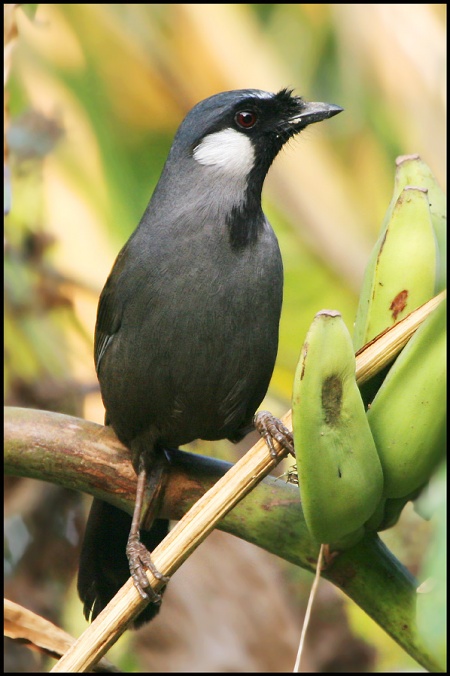- Pterorhinus chinensis
Dryonastes chinensis
Garrulax chinensis
Identification
23 - 30cm. A dark, medium-sized laughingthrush:
- Black forehead, lores and upper submoustachial area, extending as eyestripe beyond eye
- Uneven, narrow white flecks on forehead
- Slate-grey crown and upper nape
- Mid-grey mantle and dark brown upperparts, upperwing and tail
- White ear-coverts
- Black chin, throat and upper breast
- Darkish grey underparts, germaini and monachus with brown underparts and much browner upperparts
Sexes similar. Juveniles are duller and more olive-toned overall.
Distribution
Found in southeast Asia in south China (Yunnan to Guangxi, Guangdong and Hainan), Burma, Thailand, Vietnam, Laos and Cambodia. Population in Hong Kong probably of captive origin.
Fairly common in parts of its range.
Taxonomy
There are 5 subspecies[1]:
- P. c. chinensis in southeast China, Laos and Vietnam
- P. c. lochmius in south China (Yunnan), east Burma, north Thailand and northwest Laos
- P. c. propinquus in south Burma and west Thailand
- P. c. germaini in south Vietnam and adjacent Cambodia
- P. c.. monachus on Hainan
May form a superspecies with similar Chestnut-backed Laughingthrush and has been considered conspecific. Monachus is sometimes considered a full species.
This species is sometimes placed in the genus Ianthocincla or in Dryonastes.
Habitat
Broadleaf evergreen forest and mixed forest, also secondary growth, scrub and grass. Recorded up to 1525m.
Behaviour
Diet
Feeds on insects. Takes sometimes some plant material and seeds.
Usually seen in pairs or small groups, often together with other laughingthrushes. Skulking and difficult to see, foreaging in trees, bushes and lower storey.
Breeding
Breeding season March to August. The nest is a loose cupe made of rattan, bamboo, other leaves and rootes. It's placed in a thick bush or bamboo near the ground, sometimes up to 2m. Lays 3 -5 eggs.
Movements
Resident species.
References
- Clements, J. F., T. S. Schulenberg, M. J. Iliff, S. M. Billerman, T. A. Fredericks, B. L. Sullivan, and C. L. Wood. 2019. The eBird/Clements Checklist of Birds of the World: v2019. Downloaded from http://www.birds.cornell.edu/clementschecklist/download/
- Del Hoyo, J, A Elliott, and D Christie, eds. 2007. Handbook of the Birds of the World. Volume 12: Picathartes to Tits and Chickadees. Barcelona: Lynx Edicions. ISBN 978-8496553422
Recommended Citation
- BirdForum Opus contributors. (2024) Black-throated Laughingthrush. In: BirdForum, the forum for wild birds and birding. Retrieved 26 April 2024 from https://www.birdforum.net/opus/Black-throated_Laughingthrush
External Links
GSearch checked for 2020 platform.




